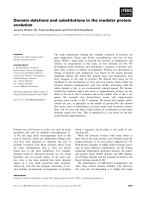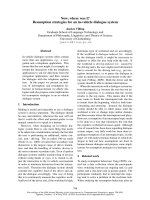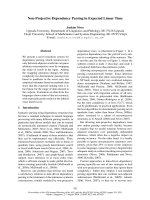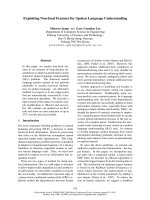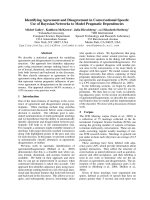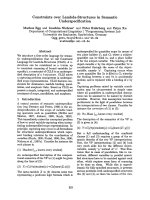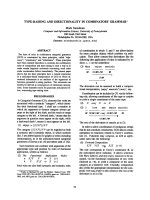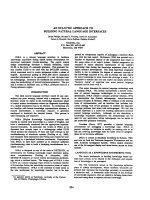Báo cáo khoa học: "Taxonomy, Descriptions, and Individuals in Natural Language Understanding" ppt
Bạn đang xem bản rút gọn của tài liệu. Xem và tải ngay bản đầy đủ của tài liệu tại đây (525.66 KB, 6 trang )
Taxonomy, Descriptions, and Individuals
in Natural Language Understanding
Ronald
J. Brachman
Bolt Beralmek and Newman Inc.
KLONE is a general-purpose language for representing
conceptual information. Several of its pr~linent
features
semantically clean inheritance of structured
descriptions, taxonomic classification of gpneric
knowledge, intensional structures for functional roles
(including the possibility of multiple fillers), and
procedural attachment (with automatic invocation)
make it particularly useful in computer-based natural
language understanding. We have implemented a prototype
natural language system that uses KLONE extensively in
several facets of its operation. This paper describes
the system
and
points out some of the benefits of using
KLONE for representation in natural
language
processing.
Our system is the beneficiary of two kinds of advantage
from KLONE. First, the taxonomic character of the
structured inheritance net facilitates the processin~
involved in analyzing and responding to an utterance.
In particular, (I) it helps guide parsing by ruling out
semantically meaningless paths, (2) it provides a
general way of organizing and invoking semantic
interpretation rules,
and
(3) it allows algorithmic
determination
of
equivalent
sets of entities for certain
plan-recognition inferences. Second, KLONE's
representational structure captures
some
of the
subtleties of natural lanKuage expression. That is, it
provides a general way of representing exactly the
quantificational import of a sentence without over-
committing the interpretation to scope or multiplicity
not overtly specified.
The paper first presents a brief overall description of
the natural language system. Then, prior to describing
how we use KLONE in the system, we discuss some of the
language's features at a general level. Finally we look
in
detail at how KLONE affords us the advantages listed
above.
1.
THE TASK AND THE SYSTEM
Generally speaking, we want to provide a natural
interface to a subsystem that knows how to present
conceptual information intelligently (on
a
bit-map dis-
play)
in
this case the Augmented Transition Network
(ATN) grammar from bae LUNAR system [5]. The informa-
tion
presentation subsystem allows flexible specifica-
tion of
coordinate
system
mappings, including rectangu-
lar
windows, from parts of the ATN onto a sequence of
"view surfaces". Object types can be assigned arbitrary
presentation forms (graphic or alphanumeric), which can
be modified
in
particular cases. Parts of the grammar
are displayed according
to
standing orders and special
requests about shape and projection.
Our task is to
command and
control the intelligent
graphics subsystem through natural language. For
example, a sample dialogue with the
system
might include
this sequence
of
utterances:
(I) Show me the clause level network.
[System displays states and arcs of the S/ network]
(2) Show me S/NP.
[System
highlights state S/NP]
preverbal states]
(4) No. I want to be able to see S/AUX.
[System "backs off" display so as to include state
S/AUK]
At the same time, we would like
to
ask factual questions
about the states, arcs, etc. of the ATN (e.g. "What are
the
conditions
on
this <user points> arc?"). Ouestions
and commands addressed to the system typically (I) make
use of elements of the preceding dialogue, (2) can be
expressed indirectly so that the surface form does not
reflect the real intent, and (3) given our graphical
presentation system, can make reference to a shared non-
linguistic context. The issues of anaphora, (indirect)
speech acts, and deixis are thus of principal concern.
The natural language system is organized as illustrated
in Figure I a. The user sits at a bit-map terminal
mi~'ti,l'
ot~v~l +
/T~X~ ~p~r ,
,J' /
Figure I. System structure
(highlighting types of knowledge involved).
equipped with a keyboard and a pointing device. Typed
input from the keyboard (possibly interspersed with
coordinates from the pointing device) is analyzed by a
version of the RU_~S System [2] ~ an ATN-based increment-
al
parser that is closely coupled with a "case-frame
dictionary". In our system, this dictionary is embodied
in a
syntactic
taxonomy represented in KLONE. The
parser produces a KLONE representation of the syntactic
structure of an utterance. Incrementally along with its
production, this syntactic structure triggers the
creation of an interpretation. The interpretation
structure the literal (sentential) semantic content
of the
utterance
is then processed by a discourse
expert that attempts to determine what was really meant.
In this process, anaphoric expressions must be resolved
and indirect speech acts recognized. Finally,
on
the
basis of what is determined to be the intended ~orce of
(3) Focus in on the preverbal constituents.
[System shifts scale and centers the display on the
a Dashed elements of the figure are proposed but not yet
implemented.
33
the utterance, the discourse component decides
how
the
system should respond. It plans its own speech or
display actions, and passes them off to the language
generation component (not yet implemented)
or
display
expert. Some of these operations will be discussed in
more detail in
Section
3.
2. THE REPRESENTATION LANGUAGE
Before we look at details of the
system's
use
Of
KLONE,
we
briefly sketch out some
of
its cogent features.
)CLONE is a unifom language for the explicit
representation of
natural
language conceptual
information based on the idea
of
structured
inheritance
networks [3]. The principal representational elements
of ~ONE
are Concepts,
of
which there are
two
major
types Generic and Individual. Generic Concepts are
arranged in an inheritance structure, expressing
long-term generic knowledge
as
a taxonomy a. A single
Generic
Concept
is
a
description
template, from
which
individual descriptions (in
the
form of Individual
Concepts) are formed. Generic Concepts can be
built
as
specializations of
other Generic Concepts, to
which
they
are attached by inheritance Cables. These Cables form
the backbone of the network (a Generic Concept can have
many
"superConcepts"
as well as many "subConcepts").
They carry
structured descriptions from
a Concept to
its
subConcepts.
KLONE Concepts are highly structured objects. A
subConoept inherits a structured definition from its
parent aa and can modify it in a number
of
structurally
consistent ways. The main elements of the structure are
Roles, which express relationships between a Concept and
other
closely
assooiatnd Concepts
(i.e. its properties,
parts, etc.). Roles themselves have structure,
including desoriptlons of potential fillers eee, modality
lnfomation, and names aaee. There are basically two
kinds of Roles in )O.ONE: RoleSets
and
IRoles. RoleSets
have potentially many fillers e~.g. the officer
Role aeaea
of
a particular COMPANY would be
filled once
for each officer). A RoleSet has as part of its
internal
structure a
restriction on
the number
of
possible fillers it can have in any particular instance.
A RoleSet on an Individual Concept stands for the
particular set of fillers for that particular concept.
An IRole (for
Instance
Role) appears on an
Individual
Concept to express the binding
of
a particular value to
the Role it plays
in
that Concept. (There would be
exactly one IRole
for
each
officer
slot
of
a particular
company, resardless
of
the actual number
of
people
playing those roles.)
There are several
inter-Role relationships in KLONE,
which relate the Roles of a Concept to those of s
sdperConcept. Such relationships are carried in the
inheritance Cables mentioned earlier. They include
- restriction (of filler description and number); e.g.
that a particular kind of COMPANY will have exactly
three officers, all ot whom must be over ~5; this is
a
relationship
between RoleSets,
in which
the more
restricted RoleSet has all of the properties of the
one it restricts, with its own local restrictions
added
conjunctively;
- differentiation (of a Role into subRoles); e.g.
differentiating the
officers of
a COMPANY
into
president, vice-president, etc.;
this is also
a
relationship between two RoleSets carrying
inheritance the more specific Roles inherit all
properties of the parent Role except for the number
restriction;
-
particularization
(of a RoleSet for an
Individual
Concept);
e.g.
the
officers of
BBN are all
COLLEGE-GRADUATEs;
- satisfaction
(binding
of
a
particular filler
description into a particular Role in an Individual
Concept); e.g. the president of BBN is STEVE-LEW:
this iS
the
relationship
between an
IRole
and
its
parent RoleSet.
Figure 2 illustrates the use
of
Cables and the structure
t The network is a partial ordering with a topmost
element the Concept of an INDIVIDUAL below which
all other Concepts appear. There is no "least" element
in the net, whose fringe is composed of Individual
Concepts not related to each other.
e, This inheritance implies inter alia that, if STATE is
a subConcept
of ATN-CONSTITUENT,
then any particular
state is by definition also an
ATN
constituent.
• ee These limitations on the fom of particular fillers
are called "Value Restrictions" (V/R's). If more than
one V/R is applicable at a given Role, the restrictions
are taken conjunctively.
• ,ae Names are not used by the system in any way. They
are merely conveniences for the user.
,mess In the text that follow, Roles will be indicated
as underlined names and Concepts will be indicated by
all upper case expressions.
Figure 2. A piece of a KLONE taxonomy.
of Concepts in a piece of the KLONE taxon¢fay for the ATN
grammar, In this figure, Concepts are presented as
ellipses (Individual Concepts are shaded), Roles as
small squares (IRoles are filled in), and Cables as
double-lined arrovJ. The most general Concept,
ATN-CONSTITUENT, has two subConcepts STATE and ARC.
These each inherit the general properties of ATN
constituents, namely, each is known to have a
34
displayForm associated with it. The
subnetwork
below
ARC expresses the classification of the various types of
arcs in the
ATN and
how their conceptual structures
vary. For example, a CONNECTING-ARC has a nextState
(the state in which the transition leaves the parsing
process), while for POP-ARCs the term is not meaningful
(i.e. there is no nextState Role). Links that connect
the Roles of more specific Concepts with corresponding
Roles in their parent Concepts are considered to travel
through the appropriate Cables. Finally, the structure
of an Individual Concept is illustrated by CATARC#0117.
Each IRole expresses the filling of a Role inherited
from the hierarchy above because CATARC#0117 is a
CAT-ARC, it has a category; because it is also a
CONNECTING-ARC, it has a nextState, etc.
The structure of a Concept is completed by its set of
Structural Descriptions (SD's). These express how the
Roles of the Concept interrelate via the use of
parameterized versions ("ParalndividJals") of other
Concepts in the network to describe quantified relations
between the ultimate fillers of the Concept's Roles.
The quantification is expressed in terms of set mappings
between the RoleSet3 of a C~ncept, thereby quantifying
over their sets of fillers. In addition to quantified
relations between potential R~le fi]lers,
simple
relations like subset and get equality can be expressed
with a special kind of SD ~:alled
a
"RoleValueMap"
(e.g.
the relation that "the object of the precondition of a
SEE is
the
same as
the object ~f its effect"). SD's are
inherited through cable~ and are particularized in a
manner similar to that of Roles.
There
is
one important
feature
of
KLONE
that I would
like to point out, although it is not yet used in the
natural
language
system. The language carefully
distinguishes between purely descriptional structure
and
assertions about coreference, existence, etc. All of
the structure mentioned above (Concepts, Roles, SD's
and
Cables) is definitional.
A
separate construct called a
Nexus is a LJsed as a locus of coreference for Individual
Concepts.
One
expresses coreference of description
relative t~ a Context by placing a Nexus in that Context
and attaching to it Individual Concepts considered to be
coreferential. AI] assertions are made relative to a
Context, and thus do not affect the (descriptive)
taxonomy
of' generic knowledge. We anticipate that
Nexuses will be important in reasoning about particu-
lars, answering questions (especially in deciding the
appropriate form for
an
answer),
and
resolving anaphoric
expressions,
and
that Contexts will be of use in
reasoning about hypotheticals, beliefs, and wants.
The final feature of KLONE relevant to our particular
application is the ahility to attach procedures and data
to structures in the network.
The
attached procedure
mechanism is implemented in a very general way. Proce-
dures are attached to k'LONE entities by "interpretive
hooks" (ihooks), which specify the set of situations in
which they are to be triggered. An interpreter function
operating on a
KLONE
entity causes
the
invocation of all
procedures inherited
by
or directly attached to that
entity by thooks whose situations match the intent of
that f.~nction. Situations include things like
"Individuate", "Modify", "Create", "Remove", etc. In
addition to a general situation, an ihook specifies when
in the executinn of the interpreter function it is to be
invoked (PRE-, POST-, or WHEN-).
3. USE OF KLONE IN THE NATURAL LANGUAGE SYSTEM
The previous section described the features of KLONE in
general terms. Here we illustrate how they facilitate
the performance of our natural language system. (Figure
I above sketched the places within the system of the
variou~ KLONE knowledge bases discussed here.) We will
discuss the use of a syntactic taxonomy to constrain
parsing and index
semantic interpretation rules,
and
structures used in the syntactic/discourse interface to
express the literal semantic content of an utterance.
The parser uses KLONE
to
describe
potential syntactic
structures. A taxonomy of syntactic constituent
descriptions, with
C~ncepts
like
PHRASE,
NOUN-PHRASE,
LOCATION-PP,
and
PERSON-WORD, is used to express how
phrases are built from their constituents.
The taxonomy
also serves as a discrimination net, allowing common
features of constituent
types
to
be
expressed
in
a
single place, and distinguishing features to cause
branching into separate subnets.
Two benefits accrue from this organization of knowledge.
First, shallow semantic constraints are expressed in the
Roles
and
SD's of Concepts like LOCATION-PP. For
example, the prepObject )f a LOCATION-PP must be a
PLACE-NOUN. A description of "on AI" (as in "book on
AI") as
a
LOCATION-PP c~Id not be constructed since AI
does not satisfy the value restriction for the head
role. Such constraints help rule out mislead in 8 parse
paths, in the manner ~f a 3emantic grammar [4], by
refusing to
construct
semantically
anomalous
constituent
descriptions. In conj~ tion with the general
(ATN)
grammar of English, this is
a
powerful
guidance
mechanism which helps parsing proceed close to
deterministically [2).
Second, the syntactic taxonomy serves as
a
structure on
which to hang semantic projection rules. Since the
taxonomy is an inheritance structure, the description of
a given syntactic constituent inherits all semantic
interpretation rules appropriate for each of the more
general constituent types that it specializes, and can
have its own special-purpose rules as well. In the
example above, simply by virtue of its placement in the
taxonomy, the Concept for "on AI" would inherit rules
relevant to PP's in general and to SUBJECT-PP's in
particular, but not those appropriate to LOCATION-PP's.
Interpretation per se is achieved using the attached
procedure facility, with semantic projection rules
expressed as functions attached to Roles of the syntac-
tic Concepts. The functions specify how to translate
pieces of syntactic structure into "deeper" Concepts and
Roles. For example, the subject of a SHOW-PHRASE might
map into
the a~ent of a
DISPLAY
action.
The mapping rules are triggered automatically by the
KLONE interpreter. This is facilitated by the
interpreter's "pushing down" a Concept to the most
specific place it can be considered to belong in the
taxonomy (using only "analytic", definitional
constraints). Figure 3 illustrates schematically the
way a Concept can descend to the most specific level
implied by its internal description. The Concept being
added to the network is an NP whose head is "ARC" and
whose modifier is "PUSH" (NP@OO23). It is initially
considered a direct (Generic) subConoept of the Concept
for its basic syntactic type (NP). Its Role structure,
however, implies that it in fact belongs in a more
restricted subclass of NP's, that is, TYPED-ARC-NP (an
NP whose head is an ARC-NOUN and whose modifier is an
ARC-TYPE-WORD). The interpreter, on the basis of only
definitional constraints expressed in the network,
places the new Concept below its "most specific
subsumer" the proper place for it in the taxonomy.
The process proceeds incrementally, with each new piece
of the constituent possibly causing further descent. In
this case, NP@O023 would initially only have its head
Role specified, and on that basis, it would be placed
under ARC-NP (which is "an NP whose head is an
ARC-NOUN"). Then the parser would add the modifier
specification, causing the Concept's descent to the
resting place shown in the right half of Figure 3. When
the constituent whose description is being added to the
network is "popped" in the parser, its
IOL.ONE
descriptiom
35
Figure U. XLONE description of
glgure 3. Automatic Concept descent.
is indtvidueted causing the invocation of all "WHEN-
Individuated" attached procedures inherited through
superconcept Cables. These procedures cause an
interpretation for the constituent to be built on the
basis of the interpretations of component parts of the
syntactic description.
This IAteral semantic
interpretation of
a phrase also
a KLONE structure is the "input" to the discourse
component. An important element of this interface
between the syntactic processor and the discourse
component is that the parser/interpreter commits itself
only to information explicitly present In the input
phrase, and leaves all inference about quantifier scope,
etc. to the discourse expert. Two kinds of representa-
tional
structures support this. The Concept O3[T (for
"determined set") is used extensively to capture sets
implicit in noun phrases and clauses. ~EYs use the
inherent multiplicity of RoleSets to group together
several entities under a single Concept, and associate
determiners (deCinlte/indeflnite, quantifiers, etc.)
with such a set of entities. A DSET can express the
characteristics of a set of entities without enumerating
them explicitly, or even indicating how many members the
set is expected to have. RoleYalueMaps a11ow
,constraints between DSETs to be expressed in a general
way a RoleValueMsp expresses a subset or equallty
relation between two RoleSets. Such relations can be
constructed without knowlng in advance the csrdinallty
of the sets or any of their members.
Figure 4 illustrates the use of these structures to
express the intent of the sentence, "Show me states
S/NP, S/AUX, and S/DCL "e. DSET#O035 represents the
interpretation of the noun phrase, "the states ~/HP,
S/AUX, and ~/DCL". The generic DSET Concept has two
Roles, mamb~r and determiner. The member Role can be
filled multiply, and therein lies the "settedness" of
the []SET. [~ET#O035 has a particularized version of the
• RoleSets in this figure are drawn as squares with
circles around them. RoleSets with filled-in circles
are a special kind
of
particularized RoleSet that can
occur only in Individual Concepts. The RoleValueMap is
pictured as a diamond.
"Show
me
states
S/NP, S/AUX, and S/DCL".
member Role: Role R1 represents the set oC three states
mentioned in the noun phrase, as a group. Thus, the
Value Restriction of R1, STATE, applies to each member.
The three 1Roles of DSETIO035, connected by "Satisfies"
links to the particularized member RoleSat, indicate
that the particular states are the members of the set e.
The other DSET in the figure, r~ETmO037, represents the
clause-level structure of the sentence. The clause has
been interpreted into something like "the user has
performed what looks on the surface to be a request for
the system to show the user some set oC states". This
captures several kinds of indeterminacy: (1) that the
sentence may only be a request at the surface level
("Don't you know that pl&s can't fly?" looks like a
request to inform), (2) that there is more than one way
to effect a "show n ("show n could mean redraw the entire
display, change it slightly to include a new object, or
simply highlight an existing one), (3) that it is not
clear how many operations are actually being requested
(showir~ three objects could take one, two, or three
actions). TherefOre, the interpretation uses Generic
Concepts to describe the kind of events appearing in the
surface form of the sentence and makes no ccmmitment to
the number of them requested. The
only
commitment to
"quantiflcetionel" information ls expressed by the Role-
ValueMap. Its two pointers, X (pointin& to the member
Role of nSET#O035) and yea (pointing to the object of
• The Value Restriction. STATE, is redundant here, since
the members of this particular set were explicitly
specified (and are known to be states). In other cases,
the information is more useful. For example, no 1Roles
would be constructed by the parser if the sentence were
"Are there three states?"; only one would be constructed
in "Show me state S/NP and its two nearest neighbors".
On the other hand, no Value Restriction would be
directly present on Role R1 if the noun phrase were just
"S/NP. S/AUX, and S/DCL".
ee ¥ is a chained pointer acing first through the member
Role of ~SET~O037, then throu6h the act Role of
S-R£QUEST~O038, and finally to the o~-ent Role of
SHOWeO035. It is considered to refer to the set of
ZRoles expressing the objects of all SHOW events
ultimately S-REQUESTed, when it is determined exactly
how many there are to be (i.e. when the 1Roles of
36
the requested
act), indicate
that the ultimate set of
things to be shown, no matter how many particular SHOW
events take place, must be the same as the set of
members in the noun phrase DSET (namely, the three
states).
As
mentioned,
semantic interpretation invokes
the
discourse
expert,
This program looks to
a plan
that it
is hypothesizing its user to
be
following in order to
interpret indirect speech acts.
Following
[1], the
speech acts REQUEST, INFORM, INFORMREF, and INFORMIF are
defined
as producing certain effects by means of the
heater's recognition of the speaker's intention to
produce these effects. Indirect speech act recognition
proceeds by inferring what the user wants the system to
think is his/her plan. Plan-recognition involves making
inferences of the form, "the user did this action in
order to produce that effect, which s/he wanted to
enable him/her to do this (next) action".
Making inferences at the level of "intended plan
recognition" is begun by analyzing the user's utterance
as
a "surface" speech act (SURFACE-REQUEST
or
SURFACE-
INFORM)
indicating what
the
utterance "looks like".
By
performing plan-recognition inferences whose
:plausibility is ascertained by using mutual beliefs, the
system can, for instance, reason that what looked to be
an INFORM of the user's goal is actually a REQUEST to
include some portion of
the
ATN into the display. Thus,
the second clause of the utterance, "No; I want to be
able to see S/AUX,"
is
analyzed as a REQUEST to INCLUDE
S/AUX by the following chain
of
plan-recognition
inferences:
The system believes
(1) the user has performed a SURFACE-INFORM of his/her
goal;
thus
(2) the user intends for the system to believe that the
user wants to be able to see S/AUX. Since this
requires that
S/AUX be
visible,
(3) the user intends for the system to believe that the
user wants the system to
plan
an action to make
S/AUX
visible.
Because the "No" leads to an
expectation
that the user might want to modify the
display, the system plans to INCLUDE S/AUX in the
existing
display,
rather
than
DISPLAY
S/AUX
alone.
(q) Hence, the user intends for the system to believe
that user wants the system to INCLUDE S/AUX.
(5) The user has performed a REQUEST to INCLUDE.
The system responds by planning that action.
In
addition to using Contexts to hold descriptions of
beliefs and wants, the plan-recognition process makes
extensive use
of
RoleValueMaps and
~SETs
(see Figure
4).
Plan-recognition inferences proceed using Just the
clause-level
structur~
and pay no attention
to
the
particulars
of
the noun phrase interpretations. The
system creates new BSETs for intermediate sets and
equates
them to
previous ones by RoleValueMaps, as,
for
example, when it decides to do a SHOW whose object is to
be the same as whatever was to be visible. At the end
of plan-recognltion the system may need to trace through
the constructed RoleValuaMaps to find all sets
equivalent to a given one. For instance, when it
determines that it needs to know which set of things to
display,
highlight, or include, it treats the
equated
RoleValueMaps
as
a
set of rewrite rules, traces back to
the original noun phrase DSET, and then tries to finds
the referent of that DSET a.
DSET#OO37 are finally specified). Thus, if there are
ultimately two SHOWs, one of one state and the other of
two,
the Y pointer
implicitly
refers to the set of all
three
states
shown.
e The system only finds referents when necessary. This
depends on the user's speech acts and the system's needs
in understanding and complying vith them. Thus, it is
Finally, not only are parse structures and semantic
interpretations represented in KLONE, but the data base
the ATN being discussed is as well (see Figure 2
above). Further, descriptions of how to display the
ATN, and general descriptions of coordinate mappings and
other display information are represented too. Commands
to the display expert are expressed as Concepts
involving actions like SHOW, CENTER, etc. whose
"arguments" are descriptions of desired shapes, etc.
Derivations of particular display forms
from generic
descriptions, or from mapping changes, are carried out
by the attached procedure mechanism. Finally, once the
particular shapes are decided upon, drawing is achieved
by invoking "how to draw" procedures attached to display
form Concepts.
Once
again, the taxone~mic nature
of
the
structured inheritance net allows domain structure to be
expressed in a natural and useful way.
Acknowledgements
The prototype natural language system was the result of
a tremendous effort by several people: Rusty Bobrow was
responsible
for
the parser and
syntactic
taxonomy,
although his support
in
design and implementation of
[CLONE was as extensive and as important; Phil Cohen
designed and built the discourse/speech act component
that does all of the inference in the system; Jack
Klovstad did the graphics, building on an existing
system (AIPS) built by Norton Greenfeld, Martin Yonke,
Eugene Ciccarelli, and Frank Zdybel. Finally, Bill
Woods built a pseudo-English input parser that allowed
us to easily build complex KLONE structures with a
minimum of effort. Many thanks to Phil Cohen, Candy
Stdner, and Bonnie Webber for help with this paper.
This research was supported by the Advanced Research
ProJects Agency of the Department of Defense and was
monitored by ONR under Contract No. N0001~-77-C-0378.
CI]
3?
[2]
[3]
References
[q]
• C5]
Allen, James F. A Plan-baaed Approach to Speech Act
Recognition. Technical Report No. 131/79. Toronto,
Ontario: Dept. of Computer Science, University of
Toronto, February 1979.
Bobrow, R. J. The RUB System. In Research in
Natural Language Understanding: Quarterly Progress
Report No. 3 (1 March 1978 to 31 May 1978). BBN
Report No. 3878. Cambridge, HA: Bolt Beranek and
Newman Inc., July 1978.
Braehman, R. J. A Structural Paradigm for
Representing Knowledge. Ph.D. Dissertation,
Harvard University, Cambridge, HA, Hay 1977. Also
BBN Report No. 3605. Cambridge, HA: Bolt Beranek
and Newman Inc., May 1978.
Burton, R. R. Semantic Grammar: An Engineering
Technique for Constructing Natural Language
Understanding Systems. BBN Report No. 3q53.
Cambridge, MA: Bolt Boranek and Newman Inc.,
December, 1976.
Woods, W. A., Kaplan, R. M., and Nash-Webber, B. The
Lunar
Sciences Natural Language Information System:
Final Report. BBN Report No. 2378. Cambridge, MA:
Bolt Beranek and Newman Inc., 1972.
intended that a naming speech act like "Call that the
complement network" will not cause a search for the
referent of "the complement network".

